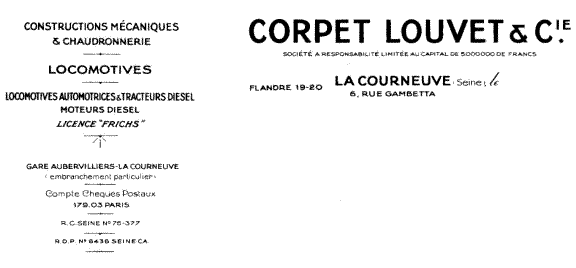
| THE INDUSTRIAL RAILWAY RECORD |
© OCTOBER 1969 |
CORPET LOUVET
LOCOMOTIVE BUILDERS
K. W. CLINGAN

The classic Corpet type. Chemins de Fer Vicinaux de la Haute Saône 39, a metre gauge 0‑6‑0 tank built in 1910 (Corpet & Louvet 1313).
(author's collection)
FORWARD
Corpet Louvet & Compagnie were one of the smaller French locomotive builders but in my opinion, one of the more interesting. To write a full history of the firm would be a fascinating task - but a time consuming one. This small work, then, is a compromise, at any rate until I, or someone else, has time to tackle the subject in greater detail. I have always found Corpet locomotives intriguing and fascinating and I have done my best to make the subject interesting.
I would like to express my thanks to the Directors and staff of Corpet Louvet for their unfailing patience with my many letters of enquiry during the past eighteen years and for kind permission to reproduce a number of official photographs. With the cessation of locomotive construction it is indeed fortunate that the firm's records were not destroyed or dispersed (as has happened with other manufacturers) and I am very grateful to the Company for loaning me in 1960 the two volumes which comprise the locomotive order book. My thanks are due also to J. D. Blyth, D. Clayton, C. H. Dickson, R. S. Fraser, J. Morley, N. A. Needle, J. H. Renaud and E. S. Tonks for their help with specific points. A word of congratulation, as well as thanks, to Chris Down for his drawing of NANTES, also to Roger West for the graphs.
At various points in the text there are page references to the following Society publications: -
| CF | — | The Industrial locomotives of Central France, |
| NEF | — | The Industrial locomotives of North Eastern France, |
| NF | — | The Industrial locomotives of Northern France, |
| SP | — | Industrial locomotives and Railways of Spain and Portugal. |
K. W. Clingan

The firm's headed notepaper used in the 1950's had a very plain style of letterhead. Only five diesels were built under the Frichs licence, but none has so far been seen and reported by any member of the Society. There is a suggestion that two were railcars built in 1937. Further details will be most welcome.
|
Chapter One |